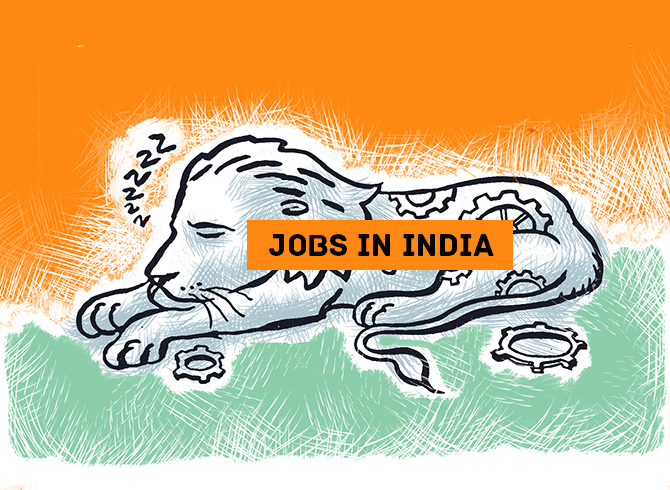The number of new jobs created declined by around 65 per cent to 64,000 in April-June 2017, from 185,000 in January-March 2017, according to the Labour Bureau’s quarterly report on employment.
Illustration: Dominic Xavier/Rediff.com

The pace of job creation in the organised sector fell sharply during April-June 2017, a three-quarter low due to significant job losses in manufacturing, latest official estimates show.
The number of new jobs created declined by around 65 per cent to 64,000 in April-June 2017, from 185,000 in January-March 2017, according to the Labour Bureau’s quarterly report on employment.
Job creation during April-June was even lower than the 77,000 reported in the same three months a year ago.
The Labour Bureau conducts an establishment-based job survey in eight sectors -- manufacturing, construction, trade, transport, education, health, accommodation and restaurants, and information technology.
These constitute 81 per cent of the total number of factories in the country employing at least 10 workers.
Finance Minister Arun Jaitley, quoting an independent study, had said while presenting the Union Budget earlier this month that various measures taken by the government had led to 7 million jobs being created in in 2017-18.
Job losses in manufacturing in April-June were 87,000.
In the previous year, 102,000 new jobs were created in the manufacturing sector.
There were 3,000 job losses in the transport sector in April-June, compared to 3,000 jobs created in January-March.
The pace of employment generation slowed down in trade and information technology.
While trade saw 7,000 new jobs being created in April-June, against 29,000 in the previous quarter, the number of new jobs in the IT and BPO sector stood at 2,000, as against 13,000 in the previous quarter.
Job creation improved in education in the first quarter of 2017-18, and 99,000 new jobs were reported, significantly higher than the 2,000 in the previous quarter.
The construction and accommodation sectors also witnessed improved job creation in the first quarter while the health sector reported new jobs at the same level as in the previous quarter’s 31,000.
Workers hired through contractors and those who were daily wage earners declined in April-June even as job creation continued its momentum among regular workers.
“Technological shifts could possibly be the reason why demand for skilled labour was more than that for semi-skilled labour.
"That is why we may be witnessing a dip in casual and contractual jobs,” said Pronab Sen, country director, IGC’s India Central Programme, and former chief statistician to the government.
The number of casual workers -- those earning daily wages -- declined by 23,000 in April-June, official estimates showed. The decline was slower than the drop of 53,000 in the previous quarter and 152,000 in October-December 2016.
The number of contract workers declined by 64,000 in April-June, more than the fall of 48,000 in the same quarter a year ago.
Most of the job losses among contract and casual workers were in manufacturing.
The number of regular jobs increased by 148,000 in April-June, less than the 197,000 in the previous quarter.
Job losses among regular workers were reported from the transport sector.











